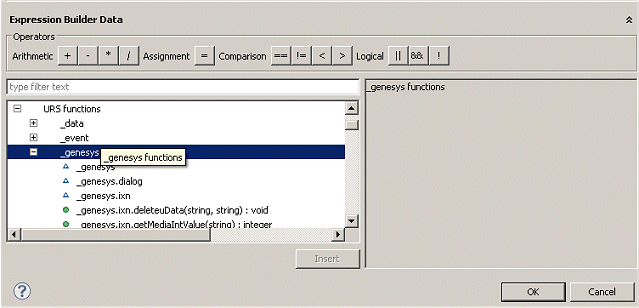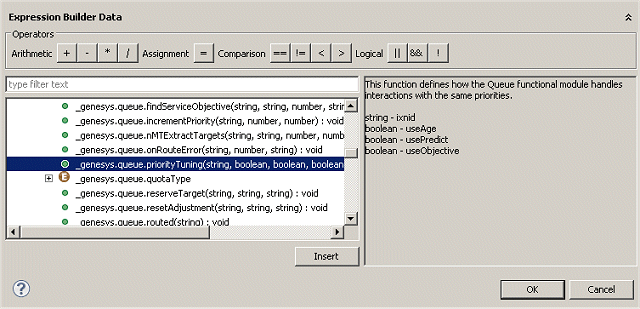Using URS and ORS Functions
Composer's Expression Builder allows you to use SCXML elements and extensions as described the Orchestration Server Developer's Guide as well as Universal Routing Server (Workflow) functions.
Expression Builder opens from many blocks; to name a few:
- Assign--Assign Data Property
- Branching--Conditions Property
- ECMAScript (for workflows)--Script Property
- Entry--Variables Property
- Log--Logging Details Property
- Looping--Exit Expression Property
Using one or more of the above blocks in a workflow gives access to functions for SCXML-based strategies. The _genesys data subcategory is where you will find modules that access Genesys-platform related objects, properties, and functions.
Below is summary information on certain functions accessible via Expression Builder.
Interaction Priority
URS always puts interactions into waiting queues according to their priorities. The priorityTuning function defines how URS handles interactions with the same priorities. By default, interactions with the same priority are ordered according to the time the interaction began to wait for some target.
- useAge parameter(true or false). If true, URS uses the time the interaction was created instead of the time interaction is placed into the waiting queue. Age of interaction is usually the time that URS starts the strategy for the interaction.
- usePredict parameter (true or false). If true, then URS calculates the estimated time for the interaction to be answered and will use this time instead of the time that the interaction has already waited.
- useObjective parameter (true or false). This parameter works with the URS use_service_objective option (Universal Routing 8.1 Reference Manual), which allows you to scale the time interval for processing different interactions. If this option set to true, URS scales the time interval that the interaction waits (or is going to wait) according to the Service Objective of the interaction
If two interactions wait the same time, such as 60 seconds, but interaction #1 has a Service Objective of 30 seconds and interaction #2 has a Service Objective of 120 seconds, then URS puts interaction #1 ahead of interaction #2 in the queue (60/30 > 60/120). The figure below shows how to access the priorityTuning function in Expression Builder.
- For more detailed information on using this function, see the Universal Routing 8.1 Reference Manual and the Universal Routing 8.1.Routing Application Configuration Guide located on the Universal Routing Wiki.
- For information on Orchestration Server functions, see Orchestration Extensions and Core Extensions topics in the Orchestration Developers Guide.


